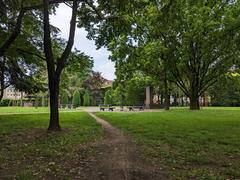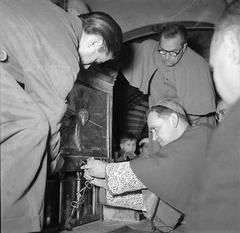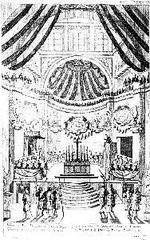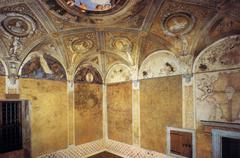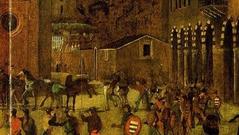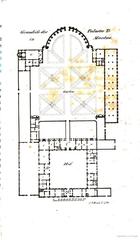Palazzo degli Studi Mantua: Visiting Hours, Tickets, and Historical Sites Guide
Date: 04/07/2025
Introduction: Historical Significance and Visitor Information
Located in the heart of Mantua, Italy, the Palazzo degli Studi is a distinguished monument representing the city’s educational heritage, architectural excellence, and ongoing cultural evolution. Commissioned in the mid-18th century by Empress Maria Theresa of Austria and designed by Alfonso Torreggiani, the palace was created to unify Mantua’s academic institutions and reflects Enlightenment ideals of progress and knowledge (skuola.net). Its design skillfully blends late Baroque and early Neoclassical styles, making it both majestic and functional.
This guide details the Palazzo’s historical development, from its origins as a Jesuit educational center to its transformation during the Habsburg reforms, and its current role in Italy’s education system. Visitors will find everything needed for a rewarding visit: hours, ticketing, accessibility, guided tours, and tips for exploring Mantua’s UNESCO-listed historic core (italiaatavola.net).
Table of Contents
- Origins and Architectural Development
- Evolution of Educational Functions
- Cultural and Social Significance
- Integration into Mantua’s Urban and Cultural Landscape
- Visiting Palazzo degli Studi: Hours, Tickets, and Visitor Tips
- Key Spaces and Collections
- Accessibility and Practical Information
- Nearby Attractions and Travel Tips
- Preservation and Contemporary Use
- Frequently Asked Questions (FAQ)
- Visual Highlights
- References
Origins and Architectural Development
Palazzo degli Studi’s foundation stems from the need to modernize Mantua’s fragmented educational system. Built between 1753 and 1763 under Maria Theresa’s commission, Torreggiani’s design replaced several scattered institutions, notably the Jesuit college at the site now occupied by the State Archives (skuola.net). The palace’s architectural language is marked by geometric symmetry, harmonious proportions, and understated ornamentation. The central courtyard, spacious halls, and stately façade embody the Enlightenment commitment to accessible, rational spaces for learning.
Evolution of Educational Functions
The educational tradition in Mantua began with the Jesuit “Collegio Gesuitico” in 1585, pivotal during the Counter-Reformation and later rebranded as “Pacifico Ginnasio Mantovano” in 1625. With the construction of the new palace, the institution was elevated to “Regio Arciducal Ginnasio” in 1760, expanding its curriculum to include law, medicine, philosophy, and theology. After the suppression of the Jesuits in 1773, the palace’s role evolved, reflecting imperial reforms and, later, integration into the unified Italian education system in 1867 (skuola.net).
Cultural and Social Significance
Palazzo degli Studi marks Mantua’s transition from religious to secular education, aligning with Enlightenment values. It served as a hub for intellectual and civic life, hosting debates, lectures, and scholarly exchanges. Its architectural grandeur and central location have made it a symbol of civic pride and educational commitment, connecting generations of Mantuan citizens.
Integration into Mantua’s Urban and Cultural Landscape
Situated within Mantua’s UNESCO World Heritage-listed center (UNESCO World Heritage), the palace is surrounded by architectural masterpieces such as Piazza Sordello, Palazzo Ducale, and Basilica di Sant’Andrea (italiaatavola.net). Its setting reinforces its role as a focal point in Mantua’s cultural and urban narrative.
Visiting Palazzo degli Studi: Hours, Tickets, and Visitor Tips
- Visiting Hours: Typically open Tuesday to Sunday, 9:00 AM – 6:00 PM; closed Mondays and public holidays.
- Tickets: Entry is free for EU citizens under 18 and over 65. Standard tickets are €5 for adults, €3 for students. Tickets are available onsite and online.
- Guided Tours: Available on weekends and by appointment; booking is recommended for groups or during peak seasons.
- Accessibility: The building is wheelchair accessible, with elevators and ramps. Assistance is available upon request.
- Photography: Permitted without flash; restrictions apply during exhibitions to protect sensitive materials.
Key Spaces and Collections
Biblioteca Teresiana
Founded in 1780 by Empress Maria Theresa, this historic library is renowned for its rare manuscripts, maps, globes, and portraits (The Art Post Blog). The reading rooms, with original wooden shelving and period furnishings, evoke the Enlightenment’s intellectual spirit.
Museo di Storia Naturale
This museum displays centuries-old collections, including fossils, animal specimens, and natural curiosities, reflecting Mantua’s scientific traditions (Wikipedia).
Sala degli Addottoramenti
A ceremonial hall adorned with ornate stucco and frescoes, used for academic ceremonies and public gatherings (FAI).
Accessibility and Practical Information
- Location: Centrally located in the pedestrian-friendly “Quartiere del Grifone,” a short walk from Mantua’s main train station.
- Transport: Accessible by train from Verona (40 min) and Milan (2 hrs). City buses and bike rentals provide easy access throughout Mantua (She Goes the Distance).
- Parking: Available outside the historic center; the core is a restricted traffic zone (Mantova Tourism).
- Facilities: Restrooms available; no cloakroom, so travel light.
- Languages: Most materials are in Italian; some English signage and brochures available. English-language tours can be arranged with prior notice.
Nearby Attractions and Travel Tips
Enhance your visit by exploring nearby highlights:
- Palazzo Ducale: Renaissance palace with rich art and history.
- Piazza Sordello: Mantua’s historic main square.
- Basilica di Sant’Andrea: Masterpiece by Alberti.
For dining, enjoy local specialities like pumpkin tortelli and sbrisolona cake (Italia.it). Accommodation ranges from boutique hotels to modern options, all within walking distance (The Travel Folk).
During cultural festivals like Mantova Summer Festival and Festivaletteratura, special openings and events may provide unique access (ItalyScapes).
Preservation and Contemporary Use
Ongoing restoration efforts ensure the palace retains its historical and architectural integrity while maintaining its status as a vibrant academic and cultural center (skuola.net). The palace hosts scholarly events, exhibitions, and conferences, fostering a dynamic bridge between past and present.
Frequently Asked Questions (FAQ)
Q: What are the Palazzo degli Studi visiting hours?
A: Tuesday to Sunday, 9:00 AM – 6:00 PM; closed Mondays and public holidays.
Q: Is there an admission fee?
A: General admission is free for EU citizens under 18 and over 65. Standard tickets: €5 adults, €3 students. Fees may apply for special exhibitions or guided tours.
Q: Are guided tours available?
A: Yes, especially on weekends and during events. Booking recommended.
Q: Is the palace accessible for visitors with disabilities?
A: Ground floor is accessible; upper floors have elevator access, but some areas may be challenging. Inquire in advance for assistance.
Q: How do I get to Palazzo degli Studi?
A: Mantua is well-connected by train; the palace is a short walk from the station. Local buses and bike rentals are also available.
Visual Highlights
Stay Updated and Explore More
For the latest visiting hours, ticket information, and events, download the Audiala app and follow us on social media. Discover more about Mantua’s historical sites and plan your cultural trip:
References and Useful Links
- Palazzo degli Studi Mantua: Visiting Hours, Tickets, and Historical Significance, 2025, skuola.net
- Mantua and Sabbioneta, 2008, UNESCO World Heritage
- 500 anni di Palazzo Te alla scoperta di Mantova da sogno tra arte e cibo, 2025, italiaatavola.net
- Wikipedia - Palazzo degli Studi (Mantova)
- The Art Post Blog - Biblioteca Teresiana
- FAI - Sala degli Addottoramenti
- Italia.it - Mantua Guide
- She Goes the Distance - Mantua
- Mantova Tourism
- ItalyScapes - Mantova Summer Festival 2025
- The Travel Folk - Things To Do in Mantua

